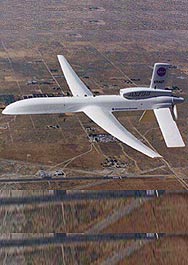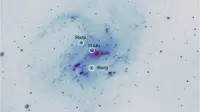Birds of a different feather
By Rajiv Singh | 20 Jan 2007
 So far, the three services have been used to handling traditional aerial systems, such as fighters, helicopters, transport - and in the case of the Army and the Air Force, also helicopter gunships. The inclusion of the UAV in their arsenal now marks the entry of a bird of an entirely different feather compared to its predecessors.
So far, the three services have been used to handling traditional aerial systems, such as fighters, helicopters, transport - and in the case of the Army and the Air Force, also helicopter gunships. The inclusion of the UAV in their arsenal now marks the entry of a bird of an entirely different feather compared to its predecessors.
UAVs form a critical layer in the integrated defence system that the three Indian defence services are now implementing in coordination with one another. They are also now a critical resource in each service's arsenal. Battle assessment and response scenarios, developed by each of the services for itself, feature the use of the UAV as a vital tool.
Though UAVs have been in service with the Indian armed forces in small numbers since the late 1990s, their mass scale adoption and integration with existing and projected fighting systems has begun in earnest only in the last couple of years. The versatility of these aircraft, and their cost effectiveness, in performing varied tasks has resulted in their being given an important position in the multi-tiered battlefield response systems that the armed forces are putting into place.
This multi-tiered system ranges across space-based systems, such as satellites tracking communications and enemy movement across physical borders, to unattended ground-based sensors the tracking movement of troops and terrorists on the border, particularly the line of control in Kashmir. The UAV occupies a critical mid-point in such a range of systems.
Already deployed
According to a 2005 Stockholm International Peace Research Institute (SIPRI) report, the Indian armed forces have bought as many as 52 Israeli Searcher UAVs, of different variants, and 42 Heron UAVs since 1996. According to the SIPRI report, deliveries of these systems commenced in 1998 and are continuing to this day.
A scan of media reports for the year 2006 gives the impression that the army has already deployed over 100 Searcher II's, and that it may have doubled the order. A January 2006 report indicates that the army has contracted with Israel Aircraft Industries for further deliveries of the Heron.
While the Searcher II has a maximum range of 150 km, and can remain airborne for 16 hours, operating at relatively high altitudes of 18,000-20,000 feet, the Heron is a fourth generation medium-altitude long-endurance system with fully automatic take-off and landing features. It can operate at altitudes of 30,000 feet, providing deep-penetration, wide-area, real-time intelligence to end-users, such as national agencies, theatre commanders and lower echelons of command.
On 23 May, India's Aeronautical Development Establishment (ADE), a premier defence laboratory, had announced that the first batch of the indigenously developed UAV, the Nishant, would be delivered to the Indian Army by the middle of 2007.
The multi-mission, state-of-the-art Nishant has been designed for any-time launch and recovery, and is unique in that it has no wheels. This 380 kg UAV is rail-launched from a hydro-pneumatic launcher, which allows subsequent launches to be carried out at intervals of 20 minutes. The Nishant's mobile hydro-pneumatic launcher system is mounted on a Tatra truck and boasts of a life cycle of 1,000 launches before overhaul.
Built to Indian Army specifications, the Nishant includes multi-mission day/night capability, and uses advanced electro-optical payloads. With a reported endurance of 4 hours plus, the Nishant will have an integrated sensor package that will allow it to gather intelligence over enemy territory, as well as perform reconnaissance, surveillance, target designation, artillery fire correction, damage assessment, ELINT (electronic intelligence) and SIGINT (communications intelligence, renamed from the earlier signals intelligence) operations.
ADE officials say that that the UAV will also have civilian applications.
Multiple roles
In November 2006, Indian Air Force chief air chief marshal SP Tyagi disclosed that the IAF had completed the induction of UAVs on schedule. Tyagi said that the UAVs "are being employed to carry out a variety of missions." He added that the IAF had been using the UAVs for some time and "it is now in the process of integrating them with various combat platforms to help generate a common picture and to reduce the sensor-to-shooter time."
According to Tyagi, the integration of the IAF's assets, including space-based ones, through net centricity and advanced communications, would add many times over to the force's punch.
As for the Indian Navy, it took delivery of six Searcher II and a single Heron UAV in 2002. After intensive trials for three years, the navy finally commissioned its UAV squadron, INAS 342, on 7 January 2006, with a complement of six Searcher IIs and six Herons.
Reports would suggest that the Indian Navy may eventually operate as many as three UAV squadrons, given the vast operational area, by way of coastline and maritime region, which it has to patrol. The navy's responsibilities extend from the Bay of Bengal in the east to the Andaman & Nicobar islands in the south and the Arabian Sea waters to the west. In these days of heightened tensions, the various choke points that control these waters, from the Strait of Hormuz leading out of the Persian Gulf to the Strait of Malacca, linking the Indian Ocean with the Pacific Ocean, and the Suez Canal, are now under the Navy's active operational purview.
International tensions apart, the navy has to be forever mindful of the fact that 95 per cent of India's trade is carried through by sea. The UAVs are admirably suited to help the force meet its responsibilities.
Combat role
If a phased induction of UAVs in the three defence services is well under way, the air force is all set to move ahead another step. In a significant announcement in November 2006, air chief marshal SP Tyagi announced the force's decision to go in for unmanned combat aerial vehicles (UCAVs).
According to Tyagi, with the IAF having completed its planned induction of UAVs required for surveillance, it was now moving towards UCAVs for offensive roles. He also said that these UCAVs were yet to be inducted into the force. Reports in the international media would, however, suggest otherwise. According to these reports, another Israeli UAV, the Harpy, which is designed to detect, attack and destroy radar emitters may already be part of the Indian arsenal, though in small numbers.
So far, the three services have inducted UAVs only from Israel, keeping in mind factors of interoperability, maintenance and cost per unit. The purchases, fairly large in number, are spread across the three services and it is only a matter of time before India's fledgling coast guard begins to look seriously at UAVs as an aid in its operations. The last reported test of the Nishant had Indian Coast Guard officials in attendance as observers.
In his November press conference, the air force chief also mentioned that any threat to the country would be tackled in an integrated manner by all the three services and that steps were under way to share and complement the resources of each of the three services.
Keeping in mind the air force chief's assertion, it would be useful to note that at the end of 2005, the army and air force had participated in a joint land and air exercise, code named Desert Strike, which was designed to test the firepower, strike and logistics capabilities of the two forces. The massive exercise, organised by the south western command of the IAF and the southern command of the Indian Army, involved an army corps. On its side, the IAF mobilised resources of the Jaisalmer Air Force Station along with elements from Agra and other bases. Searcher II UAVs were an integral part of the exercise.
For the army this biennial exercise was an opportunity to showcase its network-centric warfare capabilities, which intend to synergise and coordinate an array of sensors like radars, electro-optical devices, thermal images and UAVs through the Battlefield Surveillance System (BSS). The BSS is designed not only to increase battlefield transparency, but also to enhance the 'sensor- to-shooter' link, by ensuring quick launch of high precision weapons and munitions against the enemy.
The next such exercise is now due in 2007.
Obviously, an attempt to integrate technology platforms, weapons delivery systems, and the amalgamation of tactical and strategic doctrines amongst the three services is well under way. The UAVs, as may be evident, are not only an integral part of the Indian defence services arsenal, but also a critical link in their plans for the battlefield of tomorrow.









.webp)














